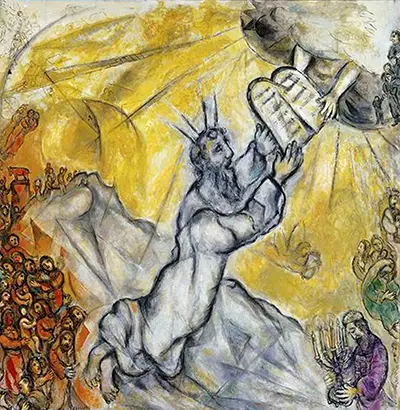At the time, the Belarus-born artist was living in France. In the image, readers see Moses receiving the clay tablets from God as described in the bible. From the look of the scenery, it is evident that he is on high ground, just as the bible records. The deity is presented as being with a shining light whose face is not shown to the reader. The rest of the people are seen waiting at the foot of the mountain. (Just as stated in the bible.). On the foreground at the right of the piece is a 7-candle menorah held by a priest (from the clothing). The sky is glowing yellow, probably from the shining light of the deity and the fact that it was a hot afternoon. There are also birds flying in the open space.
This image is motivated by the bible story of Moses getting clay tablets from God. These tablets contained the ten commandments that were to define the way of life for these people. In this particular scene, Moses had gone high up the mountain to receive the laws while people were left at the camp waiting for him. Marc has accurately depicted the story in the bible. This painting is made using the primitivism style of art. Just like the name suggests, primitivism borrowed from early drawing people made in caves and other walls of things around them. Therefore, this style mostly drew the basics of the object without giving many details. Most of such drawings did not have added colour. However, those that had colour, like the painting by Marc wasn't too detailed.
The style was also called folk art or naïve art. It was one of the easiest types of art with modern artists as it does not have many rules that govern the use of colour and representation of objects in the art piece. Besides, it shows the real events as they happen or depicted in a folk story. Marc is said to have been inspired by the works of artists such as Paul Klee, Henri Rousseau and Mikhail Larionov that had used the same styles in many pieces. He was also one of the last major artists to use the style in modern terms.
